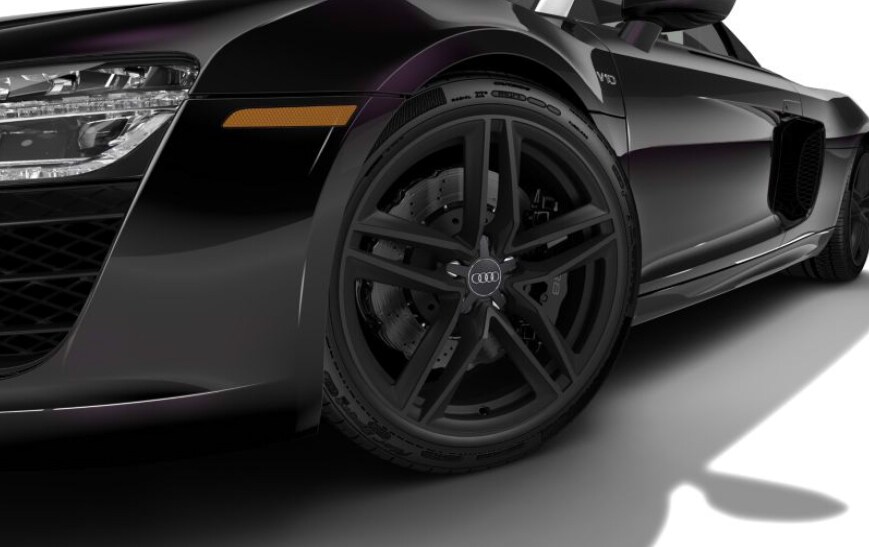5.2 Liter V10 Engine
At the heart of the R8 5.2 FSI® quattro®
is the soul stirring 525 hp 5.2 FSI V10 engine. Displayed under a
transparent panel and nestled within a Carbon Fiber Sigma engine bay,
the V10 screams to an astronomical 8700 rpm and propels the R8 5.2 to 60
mph in only 3.7 seconds on the way up to a top track speed of 196.4
mph. As part of a race-bred mid-engine design that contributes to superb
handling dynamics, the 5.2 V10 produces 101hp/liter and features race
winning technology such as FSI direct injection and a dry sump
lubrication system that assures engine lubrication under the most
demanding driving situations. It is no wonder then, that this same
engine is used in the R8 LMS GT3 race car.
quattro® All-wheel Drive
As a true supercar the R8 not only
offers blistering speed but awe-inspiring handling. Featuring the
legendary quattro® all-wheel drive system, the R8 inspires driver
confidence, giving you traction when you need it, where you need it,
regardless of road conditions. To accommodate the extreme performance of
the R8, quattro® utilizes a continuously variable torque distribution,
dynamically adjusting power to the wheels with the best traction. With a
significant 85% rear torque bias and up to 30% available for the front
wheels as needed, this highly specialized quattro® system provides the
R8 with a balanced driving experience unlike any car on the road.
FSI® Direct Injection
Audi Fuel Stratified Injection, or
FSI®, offers the benefits of increased performance and fuel efficiency.
FSI direct injection delivers a precise amount of fuel directly into the
engine cylinders as opposed to the engine intake runners. This advanced
process helps ensure a more complete combustion, thereby diminishing
waste and increasing power.
Additionally, the specially
designed piston heads compress the fuel-air mixture in a spiraling
motion, creating the most efficient combustion possible. Making the most
of these technologies allows for greater efficiency in the combustion
process.
Dry Sump Lubrication
A dry sump is an
exclusive oil system in development as a racing application that uses a
secondary external reservoir for oil, as compared to a conventional oil
system.
Dry sump lubrication offers many advantages in the R8. For
instance, under heavy acceleration or cornering, the vehicle's
powertrain components stay in place and continue to receive lubrication,
guaranteeing an even and constant supply of oil. The large reservoir
offers increased oil capacity, which ensures cool oil temperatures for
consistent performance. Also, a lower center of gravity is achieved
through a low sitting engine, giving the driver superior handling.
Audi Magnetic Ride
With thousands of miles logged on the
world's most grueling test circuit, the North Loop of the Nürburgring,
the suspension system of the R8 is further enhanced with Audi magnetic
ride, which offers instantaneous driver control at the touch of a
button. By utilizing an advanced magnetically charged fluid whose
viscosity continuously adapts to driving dynamics and can be controlled
electromagnetically, the driver can select from 'Normal' or 'Sport'
modes to customize the R8 ride and handling. The result is improved
driving dynamics, reduced body movement and better handling on the road.

Advanced Braking System
The R8 boasts a braking system
designed to match its impressive power output. The system features a
14.4" front rotor with eight pistons and a 14" rear rotor with four
pistons, all of which offers high clamp force for fast, powerful
braking. The brakes are internally vented and cross-drilled to increase
airflow and cooling, which prevents brake fade for faster stopping.
ASF®
The R8 is built with the revolutionary Audi Space Frame
[ASF®] chassis, a technology Audi invented, and has spent more than a
decade mastering. The framework of an ASF body consists of extruded
aluminum sections and pressure castings. The aluminum chassis and sheet
metal are just as strong as steel, but lighter to boost performance and
efficiency. The frame carries the sheet aluminum elements, such as the
roof panel, which helps withstand loads on the body. The elements of ASF
are varied in shape and cross-section, depending on the tasks they have
to perform. Like the bones of a bird, they combine optimal function
with low weight. The result of ASF technology is a frame that is
lightweight yet extremely strong, which delivers high torsional rigidity
and optimal performance.










